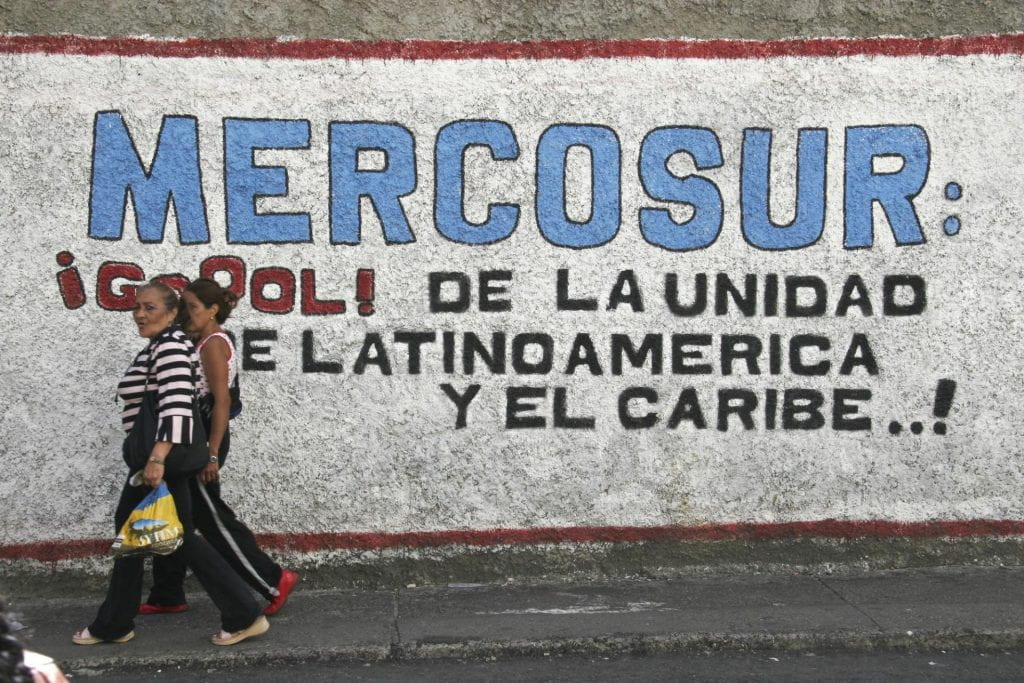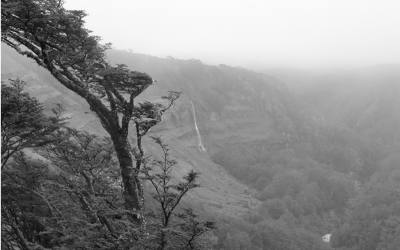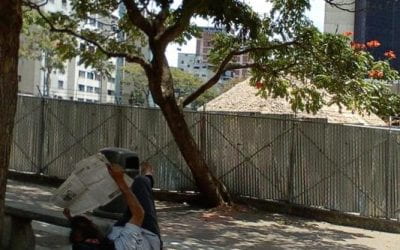Venezuela: Leading a New Trend in Latin America?
An Internationalist Vision
Hugo Chávez was elected president of Venezuela in 1998 as the result of a demand for radical change expressed by Venezuelan voters. His election also appeared to mark a wave of New Left electoral victories as Latin Americans used the ballot box to express their frustration with failed promises of market opening and democratic restoration to improve living standards of Latin Americans in the 1980s and 1990s. Following Chávez’s election, a number of leftist, socialist and social democratic candidates were inaugurated throughout the hemisphere: Ricardo Lagos of Chile in 2000, Lula da Silva of Brazil and Nestor Kirchner of Argentina in 2003, Tabaré Vásquez of Uruguay in 2005, Evo Morales of Bolivia in 2006, Daniel Ortega of Nicaragua and Rafael Correa of Ecuador in 2007, and Colom of Guatemala and Lugo of Paraguay in 2008. Venezuela was thus part of a more general demand in the region for broader social inclusion and a redistribution of political and economic resources in the face of continued poverty and high income inequality.
Overall, poverty has been reduced since 1990 from 48% to 35% on average in 2007, but individual country experiences vary widely. Chile has made the most progress with a 25% reduction, followed by Ecuador, Panama, Mexico, Peru and Brazil, all above the regional average reduction. On the other end, poverty rates have remained above 60% in the poorest countries of Nicaragua, Paraguay, and Bolivia. In the more developed countries of Argentina and Uruguay, poverty also appears to have remained stubborn at around 20%, though this masks the doubling of the poverty rate to 41% after the financial collapse in Argentina in 2001 and its subsequent recovery to the historic 20% rate with the election of the Kirchner government, and a smaller deterioration in Uruguay followed by a similar recovery after the Vásquez election. Notably, these five are all countries in which a New Left government has been elected recently, perhaps reflecting frustration with persistent poverty.
Income inequality is even more stubborn, with Latin America remaining the region of the world with the largest average income gap. The GINI index measures income inequality in countries on a scale of 0 to 1, with 1 being the most unequal. Latin America’s average is 0.53. Progress on reducing the income gap is limited: only eight countries show even a modest improvement between 0.02 and 0.04 on the 0 to 1 scale. Five other countries experienced a worsening of the income gap of between 0.02 and 0.09 points. The others remained steady.
Did lack of progress on poverty and income inequality contribute to the election of the New Left in Latin America, and have these governments succeeded in improving these social dimensions? In the New Left countries with governments in office for at least three years, we can look at the trends in poverty and income inequality before they were elected and compare them to the trends after their election. In the cases of Venezuela and Argentina, both poverty and income inequality worsened significantly in the years prior to the election of the New Left presidents, and improved in the years after. In Brazil and Chile, moderate post-dictator governments reduced poverty significantly and the New Left governments continued that reduction, but income inequality improved (modestly) only under the New Left governments. Uruguay, starting with some of the best scores in the region, has not shown significant change on either dimension before or after the election of the New Left.
Hugo Chávez came to office promising to change this scenario of poverty and inequality in a country seen by its citizens as rich with oil revenues. He began a so-called Bolivarian Revolution (named after Simón Bolívar, the South American independence leader of the early 1800s) to replace the 40-year representative democracy known as the “Punto Fijo” political system (named after a power-sharing pact among three of the major political parties to end a military dictatorship in 1958).
The Punto Fijo system had consolidated a two-party dominant party system and kept the social peace with steady economic growth and rising incomes through the petroleum boom of the 1970s. Nevertheless, increasingly rigid decision-making structures, falling oil prices, plummeting incomes, and visible corruption in the 1980s led to growing popular frustrations. Social protests grew in the 1990s, beginning with the 1989 “Caracazo” protesting neoliberal measures enacted by an aloof technocratic state, and continuing through the 1992 coup attempts and economic turmoil of the 1990s. Poverty nearly tripled, from 25% in the mid-1970s to 65% in the mid-1990s, and real per capita income in 1998 had dropped to 1963 levels—a one-third drop from the 1978 peak. Rejection of the traditional political parties began in the 1993 elections and culminated in the 1998 elections, when all of the major candidates were independents.
The Bolivarian Revolution
The rise of Hugo Chávez must be seen in this context – he epitomized the demand for change, and won the election based on a promise of radical change in the polity and economy, but with a vague ideological content. This was not a vote for a Leftist ideology, but a vote of frustration and anger and a tossing-out of the old political class that was perceived to be corrupt and incompetent. Chávez’s own ideology evolved over time from its beginning as a nationalistic, participatory project without a clearly articulated economic plan. His government has reflected a great degree of pragmatism as it has adapted to changing international economic circumstances and responded to domestic political challenges.
With oil prices at a historic low at $9/barrel in 1999, the Chávez administration’s initial economic policy followed the austerity programs and even completed some privatization initiatives begun in the previous administration. With little economic leeway, Chávez focused on politics and moved first to engineer a “refounding” constitutional project, a move followed later by Ecuador and Bolivia. The 1999 Constitution essentially followed the statist approach of the 1961 Constitution, protecting private property while giving the state responsibility for social welfare, but also rolling back some of the neoliberal reforms in the labor market and pensions. The constitution deepened human rights and citizen participation mechanisms, but also strengthened an already centralized, presidentialist system, weakening the recent decentralization reforms.
Over the course of the first three years, Chávez confronted in a systematic way each powerful organized interest as he carried out his mandate for change, and they in turn resisted to the point of extreme polarization and social conflict in 2002-2004. Chávez’s defeat of each strategy by his opponents to remove him (coup, mass protests, national petroleum strike, and recall referendum) ended up strengthening him. His reelection with 63% of the vote in 2006 apparently encouraged him to propose even more radical change in a second constitutional project in 2007, which was ultimately rejected by the voters in a referendum in December of that year.
Institutionally, the 2007 proposed constitutional reforms would have deepened the executive control of the political system, concentrating power to an extraordinary degree. It would have created a system of executive-community relationships and new regional vice presidencies parallel to (and thus weakening) popularly elected regional and local officials. It would have given the executive further control over the Central Bank, weakened due process under states of emergency, and allowed for continuous reelection of the president.
Chávez’s economic model, referred to as “socialism of the XXI century,” has not been clearly defined. It seems to be a mixed economy with multiple definitions of property rights (the 2007 constitutional reform proposals included social property, collective property, cooperative property, and private property). It allows for foreign investment, but in strategic sectors only, through joint ventures with majority control by the Venezuelan state. It provides for social welfare through executive control of oil revenues—both reinvestment decisions and massive spending on social programs for the poor called misiones.
The Bolivarian Revolution thus represents some change and some continuity compared with the previous Punto Fijo regime. Continuities include some of the basic traits of post-1958 politics: dependence on oil revenues; highly centralized decision-making structures with a new set of privileged actors excluding the traditional elites; reliance on the distribution of oil rents; and inattention to the regulative and administrative capacities of the state (though there is increased tax collection capability).
Change includes centralization of decision-making in one person (the president) rather than two hierarchical political parties; emphasis on class divisions rather than cross-class alliances; emphasis on confrontation and elimination of opponents to achieve change rather than consensus-seeking to achieve stability; dismantling of traditional representative institutions and erosion of separation of powers in favor of new forms of participatory democracy and accountability.
In other words, during the Punto Fijo political system political leaders prioritized consensus in the search for democratic stability, but at the cost of masking differences among Venezuelans. The process of change under Chávez, in contrast, emphasizes societal differences and foments confrontation in order to achieve change, but in the process it masks what Venezuelans have in common and threatens national unity.
An Internationalist Program
Chávez’s program is very much an internationalist one. It follows a Bolivarian inspiration comprised of both a Latin American integrationist dream and a centralization of domestic power. Foreign policy is fundamental to the project, which has as its goal counter-balancing U.S. global and regional hegemony with a more multipolar world. Although the Chávez administration’s antipathy towards the United States deepened after the U.S. applauded the short-lived April 2002 coup against the president, his distancing had begun long before. During his first year in office in 1999, the administration rejected a U.S. naval carrier sent to assist with massive flooding and ended U.S. drug overflights in Venezuelan airspace.
The mutual dependence of the United States and Venezuela on the petroleum trade reflects the pragmatism and constraints on each country, even while accusatory political rhetoric has soared. The United States continues to be the major trade partner for Venezuela, buying 60% of its oil exports, which comprise 10-15% of U.S. oil imports. This relationship has not been interrupted, though Venezuela strives to diversify its oil market and build alternative coalitions to counter U.S. hegemony and the United States seeks to isolate Venezuela politically in the region.
Likewise, Venezuela maintains a tense relationship with its neighbor Colombia, which is closely allied with the United States. Colombia is the second major trading partner for Venezuela, and Venezuela is dependent on imported food from Colombia, especially as food shortages have arisen in Venezuela in 2008. Venezuela’s attempt to control soaring inflation through food price controls and foreign exchange controls, combined with soaring world food demand, led to serious shortages of milk, eggs, meat and rice. Venezuela also became involved, with the permission of the Colombian government, in negotiating a humanitarian hostage exchange with the FARC guerrillas. After securing the release of two hostages, Venezuela’s negotiating role was cut off by the Colombian government because of perceived intervention in Colombian domestic affairs. The relationship further deteriorated after a Colombian raid on a FARC guerrilla camp captured laptop computers with messages appearing to indicate Venezuelan complicity in arms and financial support to the FARC, both denied by Venezuela.
Venezuelan governments have long engaged in petro-diplomacy during oil booms. The Chávez government is no exception, with the creation of several discounted oil payment programs for the Caribbean, Central America, and members of its Bolivarian Latin American Alternative (ALBA) association. The ALBA was created as an alternative to the Free Trade of the Americas negotiations (now defunct) in order to highlight an alternative economic model and create trade, financial, and political ties between its members. Thus far, its membership has not grown beyond Cuba, Nicaragua and Bolivia. Although the Chávez government has severely criticized individual free trade agreements between Latin American governments and the U.S. and European Union, Venezuela itself has maintained its commercial relationship with the U.S., and Nicaragua belongs both to the ALBA and to the Central American Free Trade Agreement with the U.S. (CAFTA).
Chávez has also promoted South American integration, and in this sense joins with Brazil in its goal of increased continental ties. Venezuela is seeking to join the Common Market of the South (Mercosur), and is promoting other integrationist schemes such as a South American energy market and a developmental Bank of South America, all meant to encourage southern development without dependence on the U.S. and multilateral organizations dominated by the North, such as the International Monetary Fund and World Bank. Further abroad, the Chávez administration has strengthened commercial relationships with Iran and China, and has played a leading role in OPEC’s strategy of curtailing production in order to raise oil prices since 1999.
A Venezuelan Model?
Does Venezuela represent a new model of Southern independence from the North, participatory and inclusive democracy, and state-led development? The Bolivarian Revolution as a model is not easily replicated or exported. Based on extraordinary oil revenues, personal charisma, and a willingness to concentrate power, the conditions giving rise to and sustaining the Bolivarian Revolution are not all present in any other country. These conditions include a near tripling of the poverty rate from the 1970s to the 1990s with its accompanying sense of exclusion and rage, a complete deinstitutionalization of a strong party system over the course of the 1990s, and a seven-fold increase in the price of the major commodity from the beginning of the Chávez administration in 1999 to 2006.
While Venezuela’s neighbors are also enjoying unusual commodity booms, none enjoys the degree of windfall revenues and the concomitant independence of international economic constraints that Venezuela does (nor the same degree of reliance on a single commodity). While others also suffered from party system collapse, none moved to de-institutionalize so severely, impeding the ability to create new, viable political parties. And while others have had long-term structural poverty, none (with the exception of Argentina in 2000-2001) had such a social dislocation as Venezuela’s middle-class slide downward, within a culture of perceived birthrights to oil riches.
Ecuador and Bolivia are often cited as following in the Venezuela model, each engaged in a refounding constitutional project aimed at redistributing economic and political resources to better include the poor and marginalized. Each, however, has historic grievances and political conflicts different from Venezuela, and is pursuing its own strategies to achieve change. Other South American countries and potential allies, such as Brazil, Argentina and Chile, are careful to maintain diverse relationships, keeping positive relations with the U.S. as well as with Venezuela. They join Chávez’s Latin American integration goals while resisting his U.S.-bashing rhetoric and confrontational tactics.
Venezuela’s domestic political transformation is still in process, with a consolidated model not yet clear. On the one hand, Venezuela has experimented over the last eight years with a number of citizen participatory models, from the early Bolivarian Circles to the most recent Communal Councils, attempting to mobilize citizens from below to provide new forms of citizen participation, empowerment, and decision-making. It is exciting to see these experiments. On the other hand, the democratic transformation has produced a dangerous level of conflict and polarization that first threatened to erupt into violence in 2002-2003. More recently, there has been an extraordinary concentration of power in the executive.
Venezuela has thus achieved one aspect of democratic transformation—it has given visibility and dignity to a previously marginalized class of citizens, redistributed resources and changed the balance of power. But Venezuela has done so at the cost of destroying old institutions or subordinating them to the president. While the viability of new forms of citizen participation are still being tested and many marginalized citizens now feel included, a new form of intolerance, the creation of the Other, prevents the creation of a shared national purpose with all crucial social sectors having a stake in ensuring its success.
Jennifer McCoy is Professor of Political Science at Georgia State University and Director of the Americas Program at The Carter Center in Atlanta. She is co-editor and contributor to The Unraveling of Representative Democracy in Latin America (with David Myers, Johns Hopkins University Press, 2006).
Related Articles
Editor’s Letter: Venezuela
Long, long ago before I ever saw the skyscrapers of Caracas, long before I ever fished for cachama in Barinas with Pedro and Aída, long before I ever dreamed of ReVista, let alone an issue on Venezuela, I heard a song.
Elections and Political Power: Challenges for the Opposition
English + Español
Next month’s elections will be an important benchmark in Venezuelan politics. On November 23, voters will go to the polls to elect 22 state governors and 355 mayors in as many municipalities, as well as choose the mayor of Caracas. The elections are taking place in a political environment influenced by the abrupt proclamation of 26 laws on July 31, the last day of President Chávez’s 18-month powers to issue emergency decrees …
A Review of Tramas del mercado: imaginación económica, cultura pública y literatura en el Chile de fines del siglo veinte
Luis Cárcamo-Huechante’s new book provides us with a convincing counter-narrative, at once nuanced and succinct, to three mainstream narratives of the neoliberal free market in Chile: those of monetarist economics, promotional politics, and literary bestsellers. It covers the Pinochet dictatorship (1973-90) and the transition to democracy from its official inauguration in 1988, with the victory of the Yes vote for a return in two years’…





